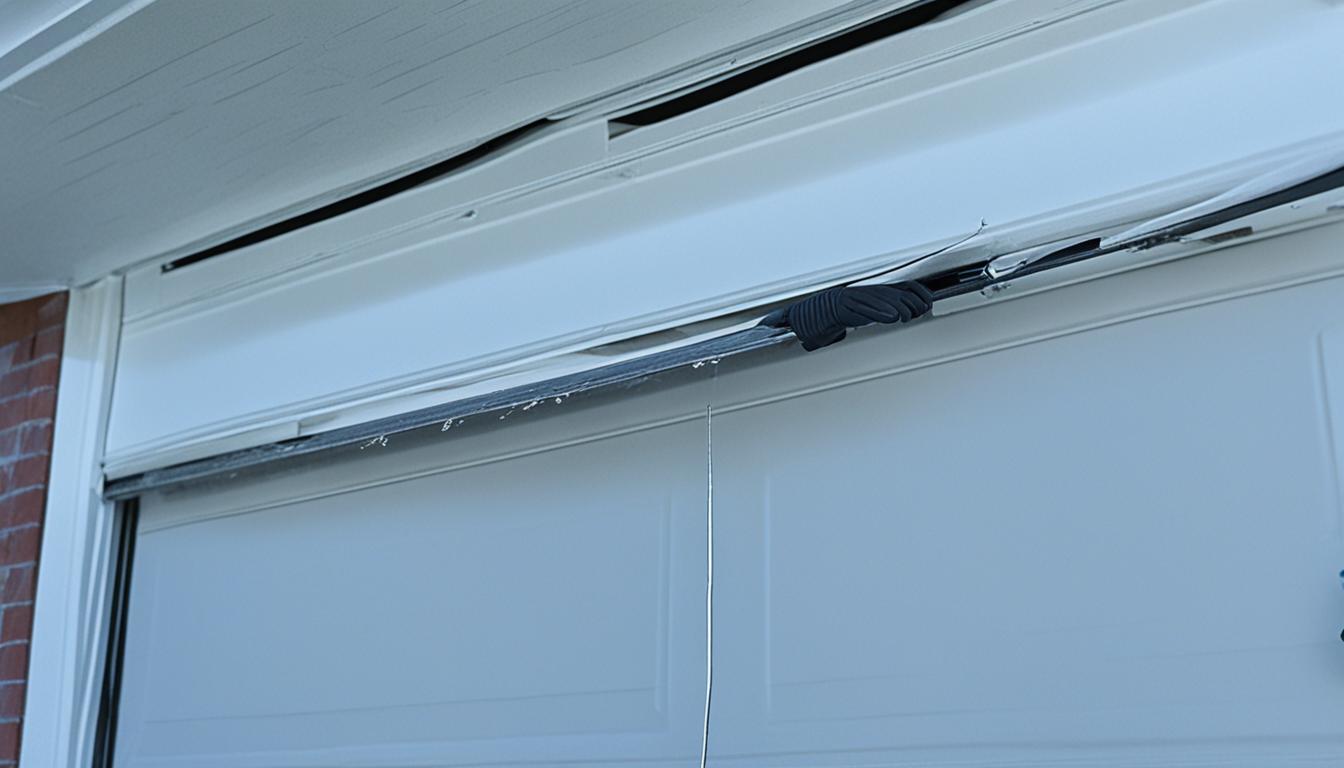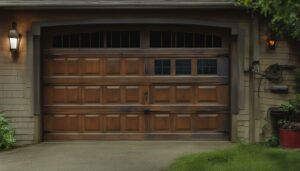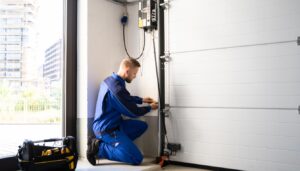Garage door weatherstripping plays a crucial role in maintaining the insulation and protection of your garage. It acts as a barrier, keeping out unwanted pests, dust, dirt, and debris, while also regulating the temperature inside. Over time, weatherstripping can wear out, leading to increased energy bills and reduced comfort. That’s why replacing weatherstripping is highly recommended by professional garage door service companies.
Key Takeaways:
- Garage door weatherstripping is essential for insulation and protection.
- Replacing weatherstripping is recommended for optimal performance.
- Weatherstripping can wear out over time, leading to increased energy bills and reduced comfort.
- Professional garage door service companies can help with weatherstripping replacement.
- Stay tuned for more information on understanding garage door weatherstripping, signs of wear, benefits of replacement, and tips for choosing the right weatherstripping material.
Understanding Garage Door Weatherstripping
Garage door weatherstripping plays a crucial role in maintaining the energy efficiency and security of your garage. It is a barrier, typically made of vinyl, rubber, or metal, that seals the gaps between the garage door and frame, preventing unwanted elements from entering and ensuring insulation.
Vinyl weatherstripping is the most popular choice among homeowners due to its durability and affordability. It effectively seals gaps and provides insulation, helping to reduce energy costs and maintain comfortable temperatures inside the garage. Rubber and metal weatherstripping options are also available, although less commonly used compared to vinyl.
When installed properly, garage door weatherstripping can seal gaps and create a tight barrier, protecting your garage from pests, dust, dirt, and outside weather conditions. It not only enhances the energy efficiency of your home but also improves comfort and reduces the risk of damage to your garage and belongings.
“Garage door weatherstripping is like a protective shield that keeps your garage secure and well-insulated. It seals gaps, offering reliable protection against unwanted intrusions and maintaining a comfortable environment inside.”
Understanding the different types of weatherstripping materials helps you make an informed decision when selecting the right option for your garage door. The next section will discuss the signs that indicate the need for weatherstripping replacement, allowing you to take timely action and ensure the optimal performance of your garage door.
Garage Door Weatherstripping Types:
| Type | Material | Features |
|---|---|---|
| Vinyl weatherstripping | Vinyl | Durable and affordable, effectively seals gaps, commonly used |
| Rubber weatherstripping | Rubber | Less commonly used, provides sealing benefits, but not as durable as vinyl |
| Metal weatherstripping | Metal | Less commonly used, provides sealing benefits, but can be less flexible and more prone to damage |
Why Choose Vinyl Weatherstripping?
Vinyl weatherstripping is the recommended choice for most homeowners due to its exceptional durability and affordability. It effectively seals gaps, provides insulation, and withstands weather conditions, ensuring long-lasting performance. Whether you have an aluminum, steel, or wooden garage door, vinyl weatherstripping is compatible with various door materials.
Next, we’ll explore the signs that indicate it’s time to replace your garage door weatherstripping so that you can maintain optimal insulation, energy efficiency, and protection.
Signs That Your Garage Door Weatherstripping Needs Replacement
If you have a garage, you know how important it is to have a properly functioning weatherstripping. Over time, garage door weatherstripping can wear out and develop signs of wear, cracks, gaps, and deterioration. Recognizing these signs is crucial as it indicates reduced effectiveness and can lead to increased energy bills and decreased comfort. Therefore, it is essential to be aware of the signs that your garage door weatherstripping may need replacement.
Signs of Wear
Inspect your garage door weatherstripping regularly for any visible signs of wear. Look for fraying edges, thinning areas, or overall deterioration. If you notice any of these signs, it is a clear indication that your weatherstripping is no longer providing the necessary protection and insulation.
Cracks and Gaps
Check for cracks or gaps in your weatherstripping. Over time, exposure to various weather conditions can cause the material to break or separate, creating openings that compromise the seal. These cracks and gaps allow air, moisture, pests, and debris to enter your garage, reducing its energy efficiency and potentially causing damage.
Deterioration
Weatherstripping can deteriorate over time due to exposure to weather elements and constant usage. Look for signs of deterioration such as brittleness, discoloration, or a loss of flexibility. If your weatherstripping appears worn, faded, or deteriorated, it is time for a replacement to ensure optimal insulation and protection.
Regularly inspecting your garage door weatherstripping for signs of wear, cracks, gaps, and deterioration is essential in maintaining the functionality of your garage, improving energy efficiency, and preventing potential damage. If you notice any of these signs, it is recommended to replace your weatherstripping to ensure maximum insulation and protection for your garage.
Benefits of Replacing Your Garage Door Weatherstripping
When it comes to maintaining a well-insulated and secure garage, replacing your garage door weatherstripping offers numerous benefits. By investing in this simple upgrade, you can enjoy a range of advantages that will enhance your living experience.
Reducing Energy Costs
One of the primary benefits of replacing your garage door weatherstripping is that it helps reduce energy costs. Properly installed and well-maintained weatherstripping keeps your garage insulated, preventing air leaks that can lead to energy wastage. By sealing gaps and reducing drafts, you can potentially save on heating and cooling expenses throughout the year.
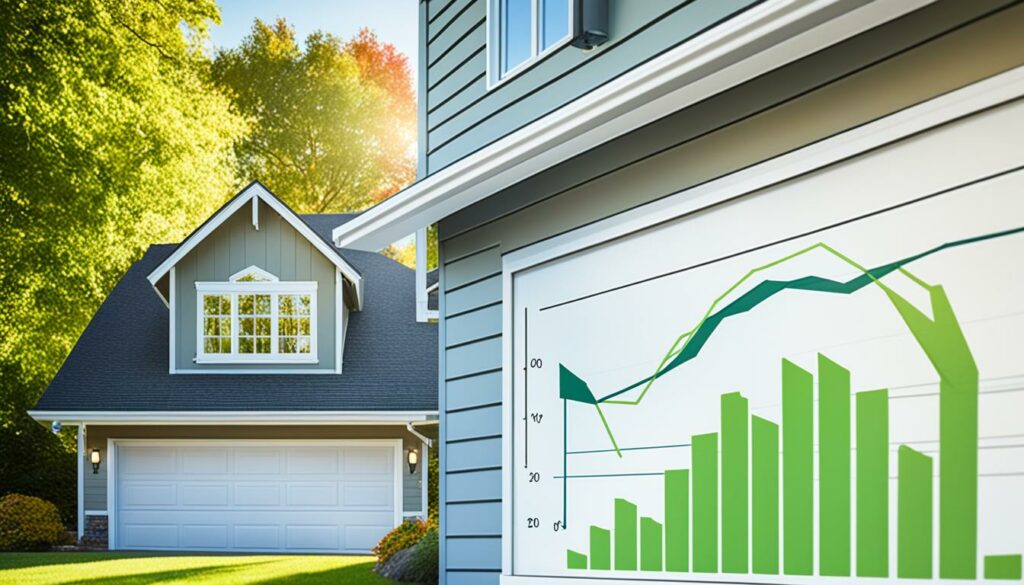
Improved Comfort
Upgrading your weatherstripping also enhances the comfort of your garage. By sealing gaps and preventing unwanted air flows, it helps regulate the temperature inside the garage. This means you’ll experience fewer temperature fluctuations, which can make the space more comfortable to use year-round. Furthermore, by keeping out dust, dirt, and pests, you can maintain a cleaner and more pleasant environment.
Enhanced Durability
Choosing high-quality weatherstripping materials and regularly replacing them ensures the enhanced durability of your garage door. Weatherstripping acts as a protective barrier between the door and the frame, minimizing wear and tear caused by constant contact. This, in turn, helps prolong the lifespan of your garage door and reduces the need for costly repairs or replacements.
By understanding and appreciating the benefits of replacing your garage door weatherstripping, you can make an informed decision that enhances both your home’s energy efficiency and your overall comfort. With reduced energy costs, improved comfort, and enhanced durability, it’s clear that investing in weatherstripping replacement is a wise choice for any homeowner.
Garage Door Weatherstripping Replacement Process
Replacing your garage door weatherstripping is a crucial step in maintaining insulation and protecting your garage from unwanted elements. Whether you choose to tackle it as a DIY project or prefer professional installation, understanding the replacement process is essential for a successful outcome.
Here is a step-by-step guide to help you navigate the garage door weatherstripping replacement process:
- Identify the Weatherstripping Material: Before you begin, determine the type of weatherstripping material you need for your garage door. The most common options are vinyl, rubber, and metal. Each material has its own benefits and characteristics, so choose the one that suits your needs best.
- Measure the Door Frame: Accurate measurements are crucial for a proper fit. Using a tape measure, measure the length and width of the door frame where the weatherstripping will be installed. Note down the measurements to ensure you get the right size of replacement material.
- Cut the Replacement Material: With the measurements in hand, carefully cut the replacement weatherstripping material to the appropriate size. Use a sharp utility knife or scissors to make clean and precise cuts.
- Install the Weatherstripping: Now it’s time to install the new weatherstripping onto the door frame. Begin at one corner and work your way around the perimeter, pressing the weatherstripping firmly into place. Ensure a snug fit and make adjustments as necessary.
Whether you choose to replace your garage door weatherstripping yourself or hire a professional, following these steps will ensure a seamless installation that effectively seals gaps and provides optimal insulation.
If you prefer to leave the task to experts, professional installation services are available from reputable garage door companies in your area. Their experienced technicians will handle the measuring, cutting, and installing process, giving you peace of mind knowing the job is done right.
Remember, garage door weatherstripping replacement is a cost-effective way to improve energy efficiency, enhance insulation, and protect your garage from the elements. Don’t overlook this important maintenance task.
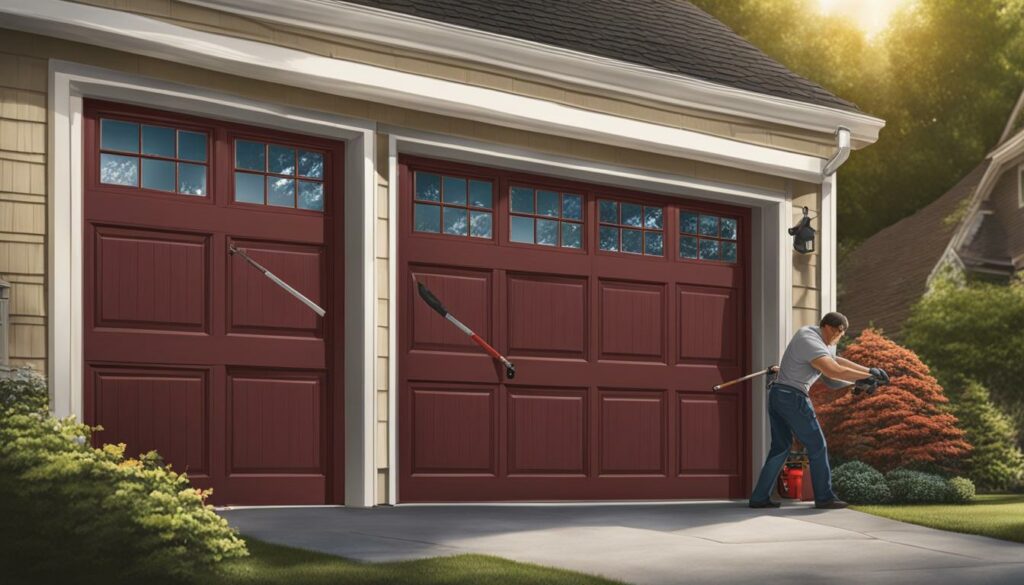
| Advantages of DIY Replacement | Advantages of Professional Installation |
|---|---|
|
|
Tips for Choosing the Right Garage Door Weatherstripping
When it comes to choosing weatherstripping material for your garage door, it’s important to consider several factors. The material you select should be durable, affordable, and energy-efficient. By prioritizing these qualities, you can ensure that your weatherstripping effectively seals gaps, provides insulation, and withstands the elements.
Durable Material
Opting for a durable weatherstripping material is crucial for long-lasting performance. Look for options that can resist wear and tear, as well as withstand extreme temperatures. Vinyl weatherstripping is known for its durability and ability to endure various weather conditions, making it a popular choice among homeowners.
Affordable Material
Choosing weatherstripping material that fits within your budget is also essential. Vinyl weatherstripping is not only durable but also affordable, making it a cost-effective option for many homeowners. Compare prices and consider the long-term benefits of each material to make an informed decision.
Energy-Efficient Material
Energy efficiency is a crucial consideration when selecting weatherstripping material for your garage door. Look for materials that effectively seal gaps and prevent air leaks. Vinyl, rubber, and metal weatherstripping all offer energy-efficient properties, but it’s important to choose the material that best suits your specific needs and climate.
By choosing the right garage door weatherstripping material, you can ensure maximum insulation, protection, and energy efficiency for your garage. Consider durability, affordability, and energy efficiency when making your selection, and enjoy the benefits of a well-sealed and efficient garage door.
Common Problems and Solutions with Garage Door Weatherstripping
Garage door weatherstripping plays a crucial role in maintaining insulation and protecting your garage from various elements. However, it can encounter common issues that need to be addressed for optimal functionality.
One common problem is freezing weatherstripping during the winter months. When temperatures drop, the weatherstripping can freeze, making it challenging to open and close the garage door smoothly. To prevent this, consider using specialized weatherstripping materials that are designed to withstand freezing conditions.
Another issue is air leaks, which can occur when the weatherstripping becomes worn or damaged. These leaks can lead to decreased energy efficiency and discomfort in your garage due to outside air entering the space. To fix air leaks, inspect the weatherstripping regularly and replace it as soon as you notice any signs of damage or wear.
Additionally, damaged weatherstripping should be promptly addressed. Whether it’s due to normal wear and tear or unexpected damage, such as from pests or excessive use, damaged weatherstripping compromises its effectiveness. Replace damaged weatherstripping to ensure proper insulation and protection for your garage.
FAQ
Why is garage door weatherstripping important?
Garage door weatherstripping is important for keeping out pests, dust, dirt, and debris, as well as regulating the temperature in your garage.
What materials are garage door weatherstripping made from?
Garage door weatherstripping can be made from vinyl, rubber, or metal, with vinyl being the most popular choice.
How can I tell if my weatherstripping needs replacement?
Signs that your weatherstripping needs replacement include cracks, gaps, visible wear marks, and deterioration.
What are the benefits of replacing garage door weatherstripping?
Replacing garage door weatherstripping reduces energy costs, improves comfort, and enhances the durability and lifespan of your garage door.
Can I replace my garage door weatherstripping myself?
Yes, garage door weatherstripping replacement can be done as a DIY project. However, you can also hire professional garage door technicians for the job.
How do I choose the right garage door weatherstripping?
When choosing garage door weatherstripping, consider factors such as durability, affordability, and energy efficiency. Choose a material that fits your budget, withstands the elements, and provides insulation.
What are common problems with garage door weatherstripping?
Common problems with garage door weatherstripping include freezing during winter, air leaks, and damage. Proper maintenance and timely replacements can address these issues.

